Abstract
Monoclonal antibodies (MAbs) against the cell surface antigens of Fusobacterium nucleatum 263 were obtained by fusion of murine myeloma cells (P3-NSI/1-Ag4-1) with the splenocytes of BALB/c mice immunized with whole cells of F. nucleatum 263. Screening was performed using an enzyme-linked immunosorbent assay (ELISA) against the immunizing strain, F. nucleatum 263. Further selection was done using a bacterial panel consisting of Bacteroides, Actinomyces, Streptococcus, Fusobacterium, and Escherichia species. Twelve MAbs were selected on the basis of this screening procedure, seven of which reacted specifically with F. nucleatum 263. Two reacted with F. nucleatum 263 and ATCC 25586, and three reacted with F. nucleatum 263, ATCC 25586, and UQD-003 (a clinical isolate) and also cross-reacted with Fusobacterium russii ATCC 25533. The selected MAbs were then further characterized by absorption experiments with suspensions of intact whole bacterial cells, and the residual binding activity of the supernatants was determined in an ELISA. To determine whether the MAbs reacted with the same or different epitopes, pairs of MAbs were reacted together and independently in a checkerboard manner in an ELISA. The additive or nonadditive nature of the reactivity was determined. A competitive inhibition assay was performed using one labeled and selected unlabeled MAbs. The results of these experiments suggested some epitope sharing among the selected MAbs that reacted with a specific antigen on F. nucleatum and also shared cross-reactive antigens with the three strains of F. nucleatum and F. russii.
Full text
PDF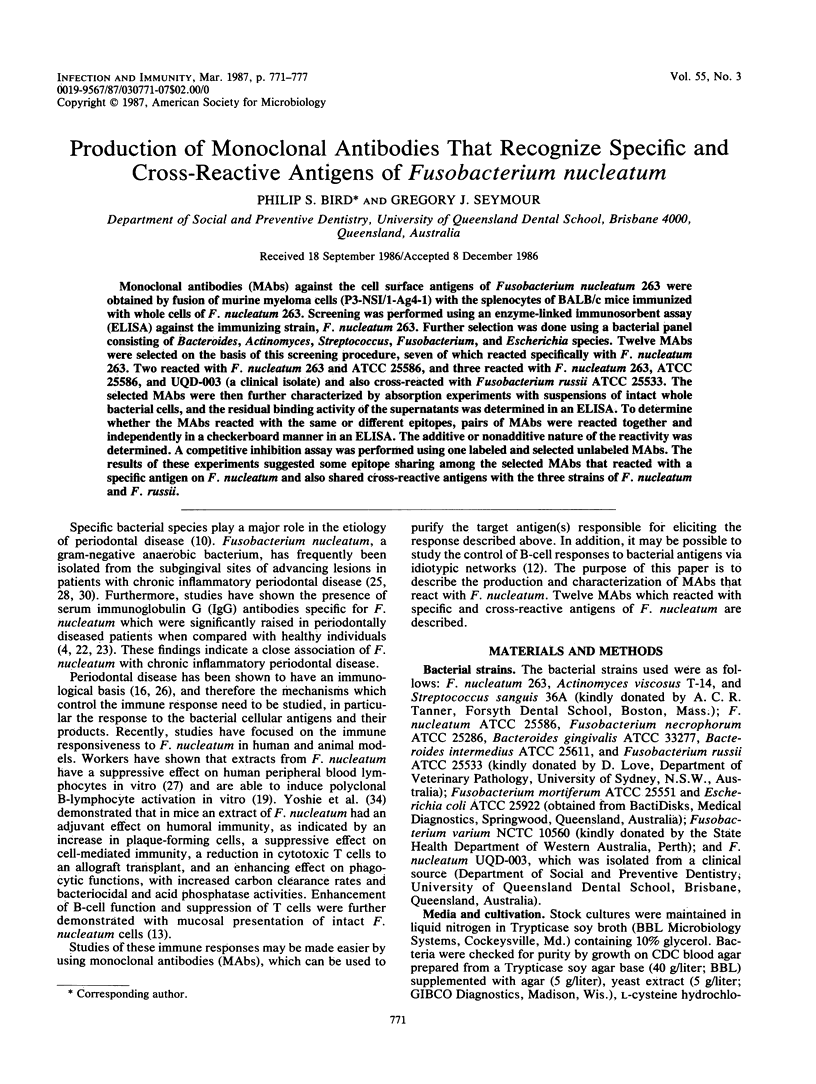
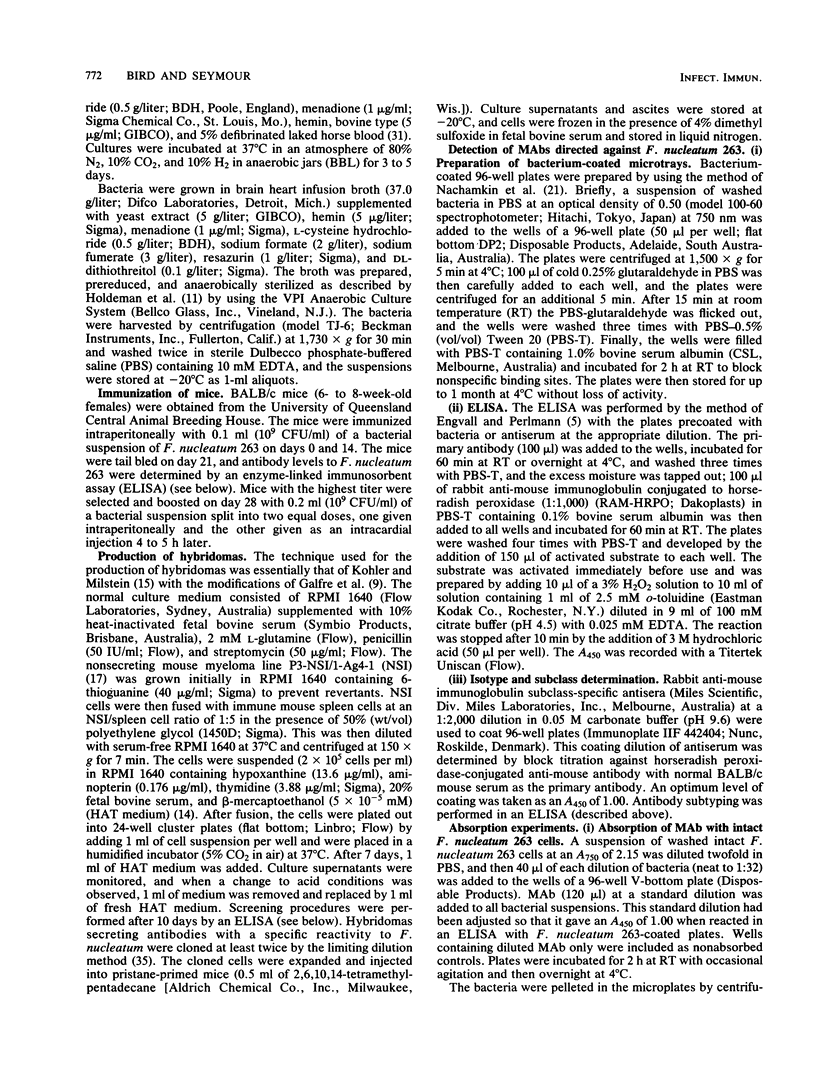
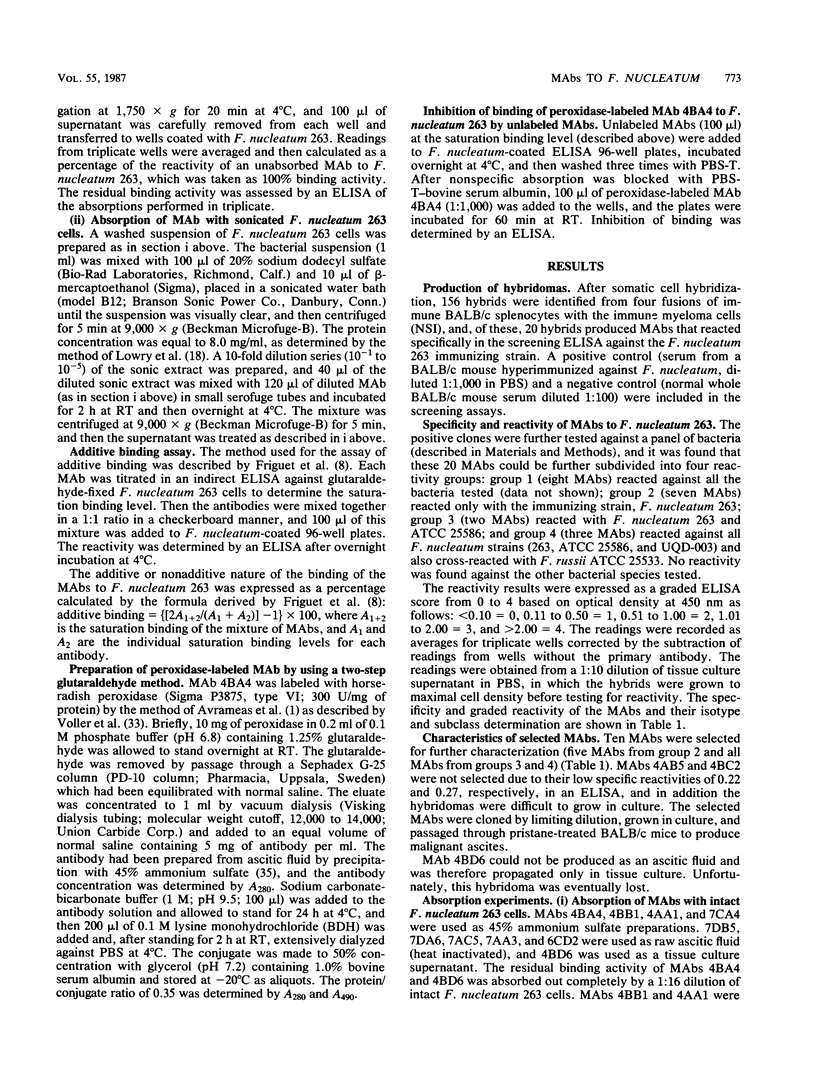

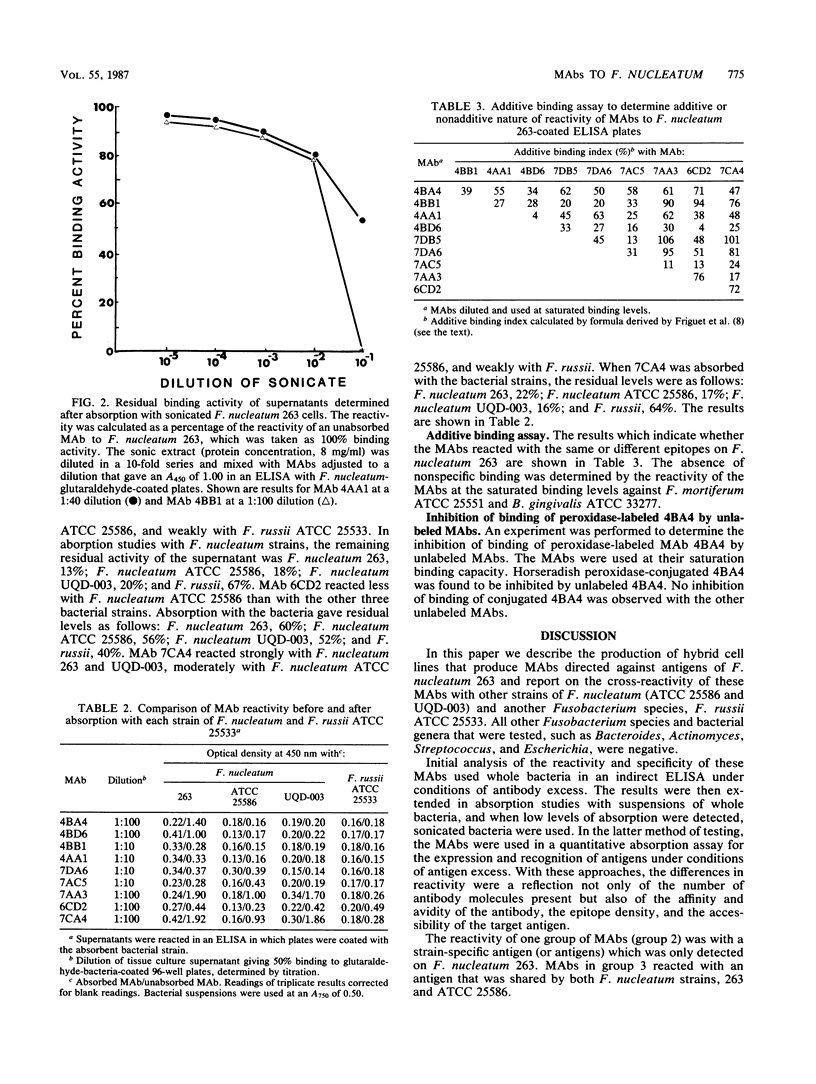

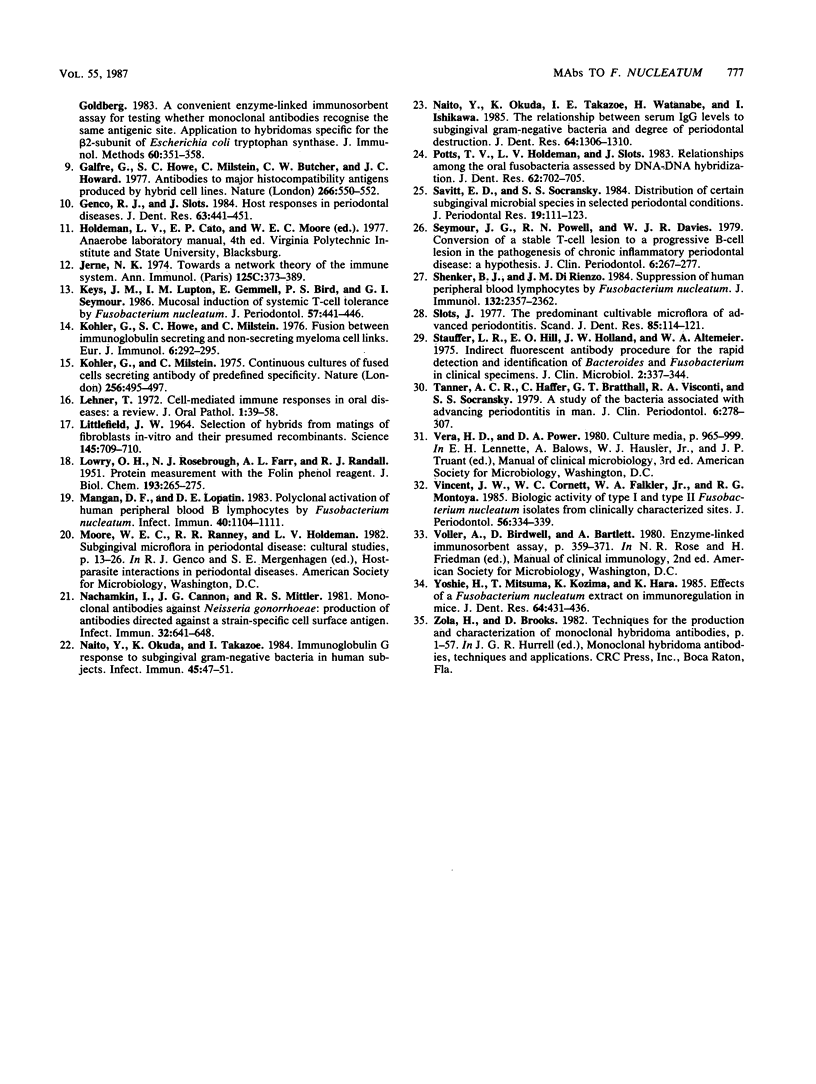
Selected References
These references are in PubMed. This may not be the complete list of references from this article.
- Cornett W. C., Vincent J. W., Gray W. A., Falkler W. A., Jr Specificity of monoclonal antibodies reactive with Fusobacterium nucleatum: effect of formalin fixation. J Immunol Methods. 1985 Nov 28;84(1-2):321–326. doi: 10.1016/0022-1759(85)90439-9. [DOI] [PubMed] [Google Scholar]
- Ebersole J. L., Taubman M. A., Smith D. J., Frey D. E., Haffajee A. D., Socransky S. S. The relationship of antibody response categories to clinical parameters of periodontal disease. J Periodontal Res. 1984 Nov;19(6):609–613. doi: 10.1111/j.1600-0765.1984.tb01325.x. [DOI] [PubMed] [Google Scholar]
- Engvall E., Perlmann P. Enzyme-linked immunosorbent assay, Elisa. 3. Quantitation of specific antibodies by enzyme-labeled anti-immunoglobulin in antigen-coated tubes. J Immunol. 1972 Jul;109(1):129–135. [PubMed] [Google Scholar]
- Falkler W. A., Jr, Hawley C. E. Hemagglutinating activity of Fusobacterium nucleatum. Infect Immun. 1977 Jan;15(1):230–238. doi: 10.1128/iai.15.1.230-238.1977. [DOI] [PMC free article] [PubMed] [Google Scholar]
- Falkler W. A., Jr, Lai R., Vincent J. W., Dober L., Spiegel C., Hayduk S. The ELISA system for measuring antibody reactive to Fusobacterium nucleatum in the sera of patients with chronic periodontitis. J Periodontol. 1982 Dec;53(12):762–766. doi: 10.1902/jop.1982.53.12.762. [DOI] [PubMed] [Google Scholar]
- Friguet B., Djavadi-Ohaniance L., Pages J., Bussard A., Goldberg M. A convenient enzyme-linked immunosorbent assay for testing whether monoclonal antibodies recognize the same antigenic site. Application to hybridomas specific for the beta 2-subunit of Escherichia coli tryptophan synthase. J Immunol Methods. 1983 Jun 10;60(3):351–358. doi: 10.1016/0022-1759(83)90292-2. [DOI] [PubMed] [Google Scholar]
- Galfre G., Howe S. C., Milstein C., Butcher G. W., Howard J. C. Antibodies to major histocompatibility antigens produced by hybrid cell lines. Nature. 1977 Apr 7;266(5602):550–552. doi: 10.1038/266550a0. [DOI] [PubMed] [Google Scholar]
- Genco R. J., Slots J. Host responses in periodontal diseases. J Dent Res. 1984 Mar;63(3):441–451. doi: 10.1177/00220345840630031601. [DOI] [PubMed] [Google Scholar]
- Jerne N. K. Towards a network theory of the immune system. Ann Immunol (Paris) 1974 Jan;125C(1-2):373–389. [PubMed] [Google Scholar]
- Keys J. M., Lupton I. M., Gemmell E., Bird P. S., Seymour G. J. Mucosal induction of systemic T cell tolerance by Fusobacterium nucleatum. J Periodontol. 1986 Jul;57(7):441–446. doi: 10.1902/jop.1986.57.7.441. [DOI] [PubMed] [Google Scholar]
- Köhler G., Howe S. C., Milstein C. Fusion between immunoglobulin-secreting and nonsecreting myeloma cell lines. Eur J Immunol. 1976 Apr;6(4):292–295. doi: 10.1002/eji.1830060411. [DOI] [PubMed] [Google Scholar]
- Köhler G., Milstein C. Continuous cultures of fused cells secreting antibody of predefined specificity. Nature. 1975 Aug 7;256(5517):495–497. doi: 10.1038/256495a0. [DOI] [PubMed] [Google Scholar]
- LITTLEFIELD J. W. SELECTION OF HYBRIDS FROM MATINGS OF FIBROBLASTS IN VITRO AND THEIR PRESUMED RECOMBINANTS. Science. 1964 Aug 14;145(3633):709–710. doi: 10.1126/science.145.3633.709. [DOI] [PubMed] [Google Scholar]
- LOWRY O. H., ROSEBROUGH N. J., FARR A. L., RANDALL R. J. Protein measurement with the Folin phenol reagent. J Biol Chem. 1951 Nov;193(1):265–275. [PubMed] [Google Scholar]
- Lehner T. Cell-mediated immune responses in oral disease: a review. J Oral Pathol. 1972;1(1):39–58. [PubMed] [Google Scholar]
- Mangan D. F., Lopatin D. E. Polyclonal activation of human peripheral blood B lymphocytes by Fusobacterium nucleatum. Infect Immun. 1983 Jun;40(3):1104–1111. doi: 10.1128/iai.40.3.1104-1111.1983. [DOI] [PMC free article] [PubMed] [Google Scholar]
- Nachamkin I., Cannon J. G., Mittler R. S. Monoclonal antibodies against Neisseria gonorrhoeae: production of antibodies directed against a strain-specific cell surface antigen. Infect Immun. 1981 May;32(2):641–648. doi: 10.1128/iai.32.2.641-648.1981. [DOI] [PMC free article] [PubMed] [Google Scholar]
- Naito Y., Okuda K., Takazoe I. Immunoglobulin G response to subgingival gram-negative bacteria in human subjects. Infect Immun. 1984 Jul;45(1):47–51. doi: 10.1128/iai.45.1.47-51.1984. [DOI] [PMC free article] [PubMed] [Google Scholar]
- Naito Y., Okuda K., Takazoe I., Watanabe H., Ishikawa I. The relationship between serum IgG levels to subgingival gram-negative bacteria and degree of periodontal destruction. J Dent Res. 1985 Nov;64(11):1306–1310. doi: 10.1177/00220345850640111101. [DOI] [PubMed] [Google Scholar]
- Potts T. V., Holdeman L. V., Slots J. Relationships among the oral fusobacteria assessed by DNA-DNA hybridization. J Dent Res. 1983 Jun;62(6):702–705. doi: 10.1177/00220345830620060101. [DOI] [PubMed] [Google Scholar]
- Savitt E. D., Socransky S. S. Distribution of certain subgingival microbial species in selected periodontal conditions. J Periodontal Res. 1984 Mar;19(2):111–123. doi: 10.1111/j.1600-0765.1984.tb00800.x. [DOI] [PubMed] [Google Scholar]
- Seymour G. J., Powell R. N., Davies W. I. Conversion of a stable T-cell lesion to a progressive B-cell lesion in the pathogenesis of chronic inflammatory periodontal disease: an hypothesis. J Clin Periodontol. 1979 Oct;6(5):267–277. doi: 10.1111/j.1600-051x.1979.tb01930.x. [DOI] [PubMed] [Google Scholar]
- Shenker B. J., DiRienzo J. M. Suppression of human peripheral blood lymphocytes by Fusobacterium nucleatum. J Immunol. 1984 May;132(5):2357–2362. [PubMed] [Google Scholar]
- Slots J. The predominant cultivable microflora of advanced periodontitis. Scand J Dent Res. 1977 Jan-Feb;85(2):114–121. doi: 10.1111/j.1600-0722.1977.tb00541.x. [DOI] [PubMed] [Google Scholar]
- Stauffer L. R., Hill E. O., Holland J. W., Altemeier W. A. Indirect fluorescent antibody procedure for the rapid detection and identification of Bacteroides and Fusobacterium in clinical specimens. J Clin Microbiol. 1975 Oct;2(4):337–344. doi: 10.1128/jcm.2.4.337-344.1975. [DOI] [PMC free article] [PubMed] [Google Scholar]
- Tanner A. C., Haffer C., Bratthall G. T., Visconti R. A., Socransky S. S. A study of the bacteria associated with advancing periodontitis in man. J Clin Periodontol. 1979 Oct;6(5):278–307. doi: 10.1111/j.1600-051x.1979.tb01931.x. [DOI] [PubMed] [Google Scholar]
- Vincent J. W., Cornett W. C., Falkler W. A., Jr, Montoya R. G. Biologic activity of type I and type II Fusobacterium nucleatum isolates from clinically characterized sites. J Periodontol. 1985 Jun;56(6):334–339. doi: 10.1902/jop.1985.56.6.334. [DOI] [PubMed] [Google Scholar]
- Yoshie H., Mitsuma T., Kozima K., Hara K. Effects of a Fusobacterium nucleatum extract on immunoregulation in mice. J Dent Res. 1985 Mar;64(3):431–436. doi: 10.1177/00220345850640030701. [DOI] [PubMed] [Google Scholar]


